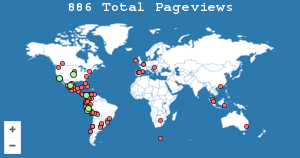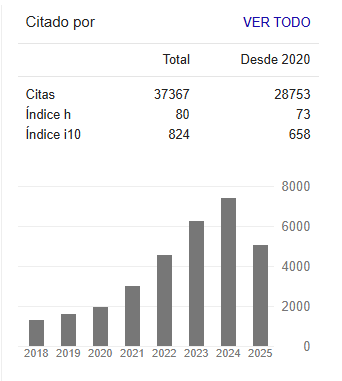Modelo de Producción en la Industria Acuícola Peruana
Resumen
Esta investigación busca validar un modelo de producción para mejorar los procesos productivos del cultivo de trucha arco iris del sector acuícola de la región sur del Perú. El planteamiento del modelo de producción se determinó a través de la combinación de las metodologías como Lean Manufacturing y Business Process Management para facilitar el control de procesos, la gestión de los inventarios y la planificación de la producción. Estas metodologías se integraron a partir de la revisión de la literatura y el diagnóstico realizado a través de la recopilación de información primaria de los productores aledaños dentro del departamento de Junín, en el centro del Perú. Los resultados dan cuenta del éxito del modelo a través de su implementación en las piscigranjas de los acuicultores de Junín y una simulación en el software ARENA versión 14.0, de este modo se obtuvieron resultados óptimos que muestran una mejora significativa de la productividad. Los resultados obtenidos luego de la implementación y la simulación muestran un incremento del 71,87% en la productividad con respecto al estado inicial, además se logra reducir en 16.67% el tiempo del ciclo de producción. Se concluye que el modelo de producción propuesto es exitoso y compatible para mejorar los procesos de producción en el sector acuícola.
Citas
Arevalo, C., Escalona, M. J., Ramos, I., & Domínguez-Muñoz, M. (2016). A metamodel to integrate business processes time perspective in BPMN 2.0. Information and Software Technology, 77, 17–33. https://doi.org/10.1016/j.infsof.2016.05.004
Asche, F., Cojocaru, A. L., & Roth, B. (2018). The development of large scale aquaculture production: A comparison of the supply chains for chicken and salmon. Aquaculture, 493, 446–455. https://doi.org/10.1016/j.aquaculture.2016.10.031
Asche, F., Roll, K. H., Sandvold, H. N., Sørvig, A., & Zhang, D. (2013). Salmon aquaculture: larger companies and increased production. Aquaculture Economics & Management, 17(3), 322–339. https://doi.org/10.1080/13657305.2013.812156
Asmae, M., Abdelali, E., Youssef, S., & Brahim, H. (2019). The utility of Lean Six Sigma(LSS) in the Supply Chain agro-industry. International Colloquium on Logistics and Supply Chain Management, LOGISTIQUA 2019, 1–7. https://doi.org/10.1109/LOGISTIQUA.2019.8907300
Aspara, J., Lamberg, J. A., Laukia, A., & Tikkanen, H. (2011). Strategic management of business model transformation: Lessons from Nokia. Management Decision, 49(4), 622–647. https://doi.org/10.1108/00251741111126521
Bazan-Rios, K., Chavez-Canales, C., Ramos-Palomino, E., Eyzaguirre-Munarriz, J., & Mesia, R. (2019). An Integrated System: Lean, Six Sigma and Theory of Constraints, a Study Applied in Wooden Furniture Industry in Lima, Peru. 2019 7th International Engineering, Sciences and Technology Conference (IESTEC). https://doi.org/10.1109/iestec46403.2019.00070
Berger, C. (2020). La acuicultura y sus oportunidades para lograr el desarrollo sostenible en el Perú. South Sustainability, 1, 1–11. https://doi.org/10.21142/ss-0101-2020-003
Bergesen, O., & Tveterås, R. (2019). Innovation in seafood value chains: the case of Norway. Aquaculture Economics and Management, 23(3), 292–320. https://doi.org/10.1080/13657305.2019.1632391
Butt, J. (2020). A Conceptual Framework to Support Digital Transformation in Manufacturing Using an Integrated Business Process Management Approach. Designs, 4(3), 17. https://doi.org/10.3390/designs4030017
Chavez, C., Bazan, K., Eyzaguirre, J. C., Ramos, E., & Basu, A. N. (2020). The Peruvian furniture industry: an integration model for lean, Six Sigma and theory of constraints. International Journal of Business Performance and Supply Chain Modelling, 11(4), 333. https://doi.org/10.1504/ijbpscm.2020.112729
Dave, Y., & Sohani, N. (2019). Improving productivity through Lean practices in central India-based manufacturing industries. International Journal of Lean Six Sigma, 10(2), 601–621. https://doi.org/10.1108/IJLSS-10-2017-0115
De Masellis, R., Di Francescomarino, C., Ghidini, C., & Tessaris, S. (2019). Solving reachability problems on data-aware workflows. https://doi.org/10.1016/j.eswa.2021.116059
Dwivedi, V. K., Islam, A., & Sharma, A. (2021). Application of 5s Methodology in a Small-Scale Enterprise: Case Study. Lecture Notes in Mechanical Engineering, 29–36. https://doi.org/10.1007/978-981-16-3135-1_4
FAO (2020). El estado mundial de la pesca y la acuicultura 2020. La sostenibilidad en acción. Roma. https://doi.org/10.4060/ca9229es.
Fernandes, J., Reis, J., Melão, N., Teixeira, L., & Amorim, M. (2021). The role of industry 4.0 and bpmn in the arise of condition-based and predictive maintenance: a case study in the automotive industry. Applied Sciences (Switzerland), 11(8). https://doi.org/10.3390/app11083438
Garza-Reyes, J. A., Yu, M., Kumar, V., & Upadhyay, A. (2018). Total quality environmental management: Adoption status in the Chinese manufacturing sector. TQM Journal, 30(1), 2–19. https://doi.org/10.1108/TQM-05-2017-0052
Gobierno Regional Junin, & Direccion regional de la Produccion. (2010). Desarrollo de la Acuicultura Continental de Aguas Frías en la Región Junín. 26.
Gošnik, D., Beker, I., Suklan, J., & Kavčič, K. (2016). Management model for successful business processes: The case of transition countries. International Journal of Industrial Engineering and Management, 7(2), 75–83.
Green, K. W., Inman, R. A., Sower, V. E., & Zelbst, P. J. (2019). Comprehensive supply chain management model. Supply Chain Management, 24(5), 590–603. https://doi.org/10.1108/SCM-12-2018-0441
Hernandez, R., Belton, B., Reardon, T., Hu, C., Zhang, X., & Ahmed, A. (2018). The “quiet revolution” in the aquaculture value chain in Bangladesh. Aquaculture, 493, 456–468. https://doi.org/10.1016/j.aquaculture.2017.06.006
Hobday, A. J., Spillman, C. M., Paige Eveson, J., & Hartog, J. R. (2016). Seasonal forecasting for decision support in marine fisheries and aquaculture. Fisheries Oceanography, 25, 45–56. https://doi.org/10.1111/fog.12083
Janssen, K., Chavanne, H., Berentsen, P., & Komen, H. (2017). Impact of selective breeding on European aquaculture. Aquaculture, 472, 8–16. https://doi.org/10.1016/j.aquaculture.2016.03.012
Kaminski, A. M., Genschick, S., Kefi, A. S., & Kruijssen, F. (2018). Commercialization and upgrading in the aquaculture value chain in Zambia. Aquaculture, 493, 355–364. https://doi.org/10.1016/j.aquaculture.2017.12.010
Kilic, R., & Erkayman, B. (2021). A simulation approach for transition to jit production system. International Journal of Simulation Modelling, 20(3), 489–500. https://doi.org/10.2507/IJSIMM20-3-566
Liker, J. K., & Morgan, J. M. (2006). The toyota way in services: The case of lean product development. Academy of Management Perspectives, 20(2), 5–20. https://doi.org/10.5465/AMP.2006.20591002
Ministerio de la produción (2020). La cadena de valor de la trucha. Pnipa, 1, 66.
Mishra, O. P., Kumar, V., & Garg, D. (2016). Investigations of JIT applicability in supply chain: Empirical evidence from Indian firms. International Journal of Business Performance and Supply Chain Modelling, 8(3), 222–249. https://doi.org/10.1504/IJBPSCM.2016.078564
Nahabedian, L., Braberman, V., D’Ippolito, N., Kramer, J., & Uchitel, S. (2021). Assured automatic dynamic reconfiguration of business processes. Information Systems, xxxx, 101850. https://doi.org/10.1016/j.is.2021.101850
Nallusamy, S., & Adil Ahamed, M. (2017). Implementation of Lean Tools in an Automotive Industry for Productivity Enhancement - A Case Study. International Journal of Engineering Research in Africa, 29, 175–185. https://doi.org/10.4028/www.scientific.net/jera.29.175
Ngniatedema, T., Chen, L., & Guiffrida, A. L. (2016). A modelling framework for improving supply chain delivery performance. International Journal of Business Performance and Supply Chain Modelling, 8(2), 79–96. https://doi.org/10.1504/IJBPSCM.2016.077163
Oddershede, A., Arias, A., & Cancino, H. (2007). Rural development decision support using the Analytic Hierarchy Process. Mathematical and Computer Modelling, 46(7–8), 1107–1114. https://doi.org/10.1016/j.mcm.2007.03.006
Rahman, M. T., Nielsen, R., Khan, M. A., & Asmild, M. (2019). Efficiency and production environmental heterogeneity in aquaculture: A meta-frontier DEA approach. Aquaculture, 509(January), 140–148. https://doi.org/10.1016/j.aquaculture.2019.05.002
Randhawa, J. S., & Ahuja, I. S. (2018). Analytical hierarchy process for selecting best attributes for successful 5S implementation. International Journal of Productivity and Quality Management, 24(1), 33–58. https://doi.org/10.1504/IJPQM.2018.091167
Sales, M., & de Castro, R. (2021). Value-based lean implementation in a surgical unit: the impact of the methodology. The TQM Journal, 33(6), 1484–1501. https://doi.org/10.1108/tqm-10-2020-0249
Stevens, J. R., Newton, R. W., Tlusty, M., & Little, D. C. (2018). The rise of aquaculture by-products: Increasing food production, value, and sustainability through strategic utilisation. Marine Policy, 90, 115–124. https://doi.org/10.1016/j.marpol.2017.12.027
Thomas, A. (2018). Developing an integrated quality network for lean operations systems. Business Process Management Journal, 24(6), 1367–1380. https://doi.org/10.1108/bpmj-02-2018-0041
Valenti, W. C., Barros, H. P., Moraes-Valenti, P., Bueno, G. W., & Cavalli, R. O. (2021). Aquaculture in Brazil: past, present and future. Aquaculture Reports, 19, 100611. https://doi.org/10.1016/j.aqrep.2021.100611
Valverde, J., & Varela, A. (2020). Efecto de la densidad de siembra en la productividad y rentabilidad del langostino Macrobrachium rosenbergii en la fase de engorde en estanques, Costa Rica. Revista de Investigaciones Veterinarias del Perú, 31(3), e18174. https://doi.org/10.15381/rivep.v31i3.18174
Zaninelli, M., & Pace, M. R. (2018). The O3-farm project: First evaluation of a business process management (BPM) approach through the development of an experimental farm management system for milk traceability. Agriculture (Switzerland), 8(9). https://doi.org/10.3390/agriculture8090139
Zhu, X., Vanden Broucke, S., Zhu, G., Vanthienen, J., & Baesens, B. (2016). Enabling flexible location-aware business process modeling and execution. Decision Support Systems, 83, 1–9. https://doi.org/10.1016/j.dss.2015.12.003

Esta obra está bajo licencia internacional Creative Commons Reconocimiento-NoComercial-CompartirIgual 4.0.








.png)






























